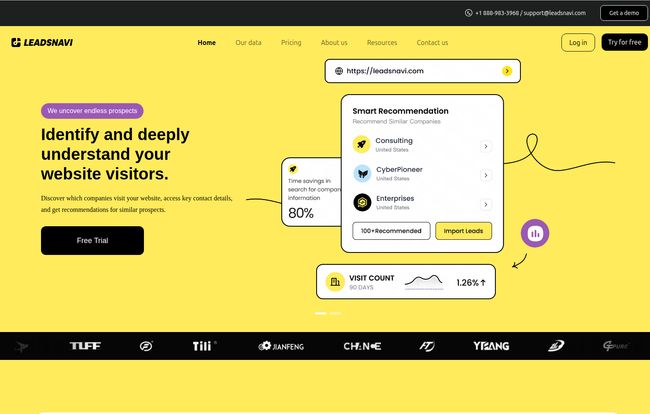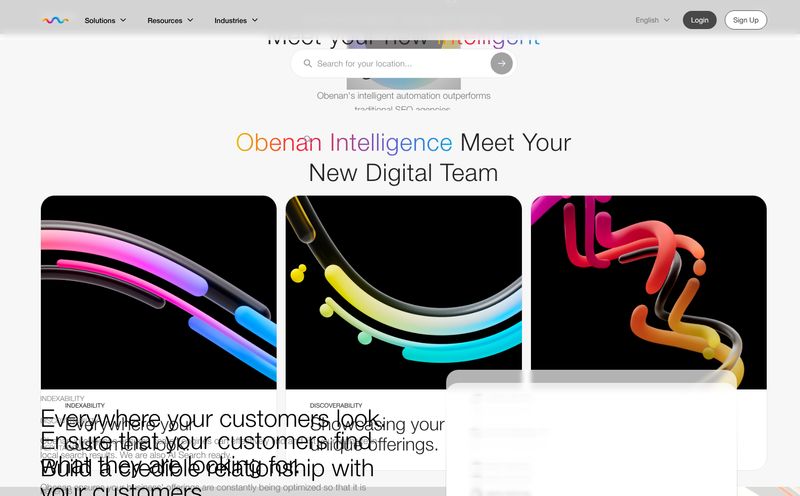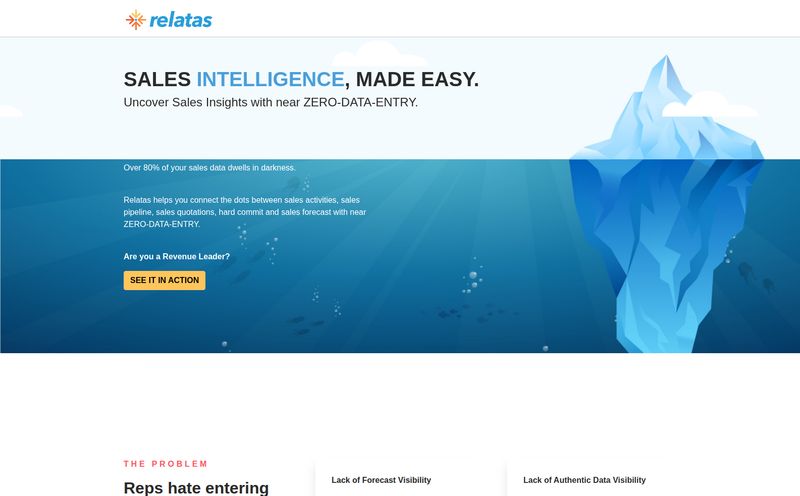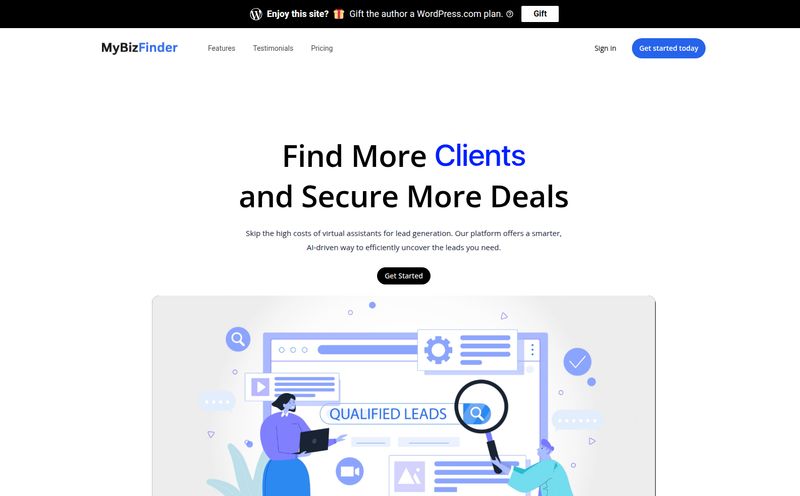You spend a small fortune on Google Ads, you bust your butt on SEO, you create content until your fingers are sore. The traffic comes. You watch the little line go up in Google Analytics and you feel a brief, fleeting moment of joy. But then the silence hits. Who are these people? For B2B businesses, this is the million-dollar question. You know some of them must be from your target accounts, the ones your sales team has been trying to crack for months. But they're ghosts. Anonymous sessions in a sea of data.
I’ve been in the traffic generation game for years, and this has always been the great frustration. It’s like throwing a fantastic party but not knowing who showed up. For a while now, a category of tools known as website visitor identification platforms have promised to lift that veil. I've tried a bunch, from the big, expensive juggernauts to the scrappy upstarts. Recently, a new name popped onto my radar: LeadsNavi. Their pitch is bold, especially on price, so I figured it was time to kick the tires and see if it could actually deliver.
So, What is LeadsNavi, Really?
In the simplest terms, LeadsNavi aims to be the caller ID for your website. It’s a SaaS tool, sprinkled with a bit of AI magic, that works to unmask the anonymous companies visiting your site. Instead of seeing an anonymous IP address from Somewhere, USA, you see that someone from 'MegaCorp Inc.' just spent ten minutes reading your case studies. Now that is a conversation starter for your sales team.
It does this primarily by cross-referencing a visitor's IP address with a massive database of company information. It's not voodoo; it's just smart data work. The goal is to turn your passive website traffic into an active, throbbing list of warm B2B leads. A pretty compelling idea, right?
Peeking Under the Hood: The Core Features
A tool is only as good as its features, and LeadsNavi seems to understand the B2B sales and marketing workflow. It isn't just a one-trick pony.
Identification is Just the Start
The main event, of course, is the IP address identification. This is table stakes for any tool in this category. The dashboard, based on the images I've seen, gives you a clean feed of the companies that have been on your site, along with what they looked at and for how long. Knowing that AlphaTech spent 15 minutes on your pricing and integration pages is infinitely more valuable than just seeing an anonymous visitor from their city.
Getting the Full Scoop: Company and Contact Details
Here’s where things get interesting. Identifying the company is great, but who do you call? LeadsNavi goes a step further by providing detailed company profiles and, crucially, potential contact information for people within that company. This is the bridge between a cool piece of data and an actual sales opportunity. No more endless searching on LinkedIn; you get a starting point delivered right to you. This is the feature that separates the truly useful tools from the novelties.

Visit LeadsNavi
AI-Powered Matchmaking
I'll admit, my eyes tend to glaze over when I see "AI-powered" for the tenth time in a day. It's often just marketing fluff. But LeadsNavi’s 'Similar Company Recommendations' feature actually sounds useful. It analyzes the profile of companies that are showing interest and suggests other, similar companies you should be targeting. Think of it as a built-in prospecting assistant. Instead of just reacting to visitors, it helps you proactively find your next best customer. I like that a lot.
Connecting the Dots with CRM Integration
Any marketing or sales professional knows the pain of a tool that doesn't talk to their other systems. A new lead source that lives in a silo is a data graveyard waiting to happen. LeadsNavi boasts CRM integration, which is absolutely critical. Pushing these identified, high-intent companies directly into your Salesforce, HubSpot, or whatever you're using is how you turn insight into action efficiently. Without it, you're just creating more manual data entry for your team, and nobody wants that.
Let's Talk Money: A Look at LeadsNavi's Pricing
This is where LeadsNavi really got my attention. They make a pretty wild claim on their site about being
just 1/4 of common market prices!
That’s a bold statement in a field with some very expensive players. So, how does it actually break down?
The pricing structure is refreshingly simple and seems designed to get you in the door without a huge commitment.
- Free (Starter Plan): This is your test drive. You get to identify a total of 100 companies. It's a great way to prove the concept and see if the tool can actually recognize the kind of businesses you care about. A heads-up, though: the free plan doesn't include the juicy contact information. It shows you the 'who' (the company), but not the 'how' (the contact person).
- Basic Plan ($49/month): This feels like the sweet spot for most small to medium-sized businesses. For less than fifty bucks a month, you get unlimited users and can identify up to 400 companies. This is where you get the contact details and can start building a real pipeline. Compared to some competitors who start in the hundreds of dollars, this price is extremely competitive.
- Scale Plan (Talk to Sales): This is the classic enterprise-level plan. If you're a larger organization with high traffic volume and need custom solutions, you'll have a conversation with their sales team to build a package. This includes unlimited data storage and more tailored support.
My take? The pricing is smart. The free plan is a no-risk way to validate the technology. If you see quality companies pop up, the $49/month for the Basic plan is an incredibly low barrier to entry to start getting actionable leads.
The Good, The Bad, and The Honest Truth
Alright, no tool is perfect. After looking it all over, here’s my rundown of what stands out, for better or for worse.
What I Really Like
The pricing, obviously. It’s disruptive. For a startup or an SMB that's been priced out of tools like ZoomInfo or Leadfeeder, LeadsNavi could be a game-changer. They're claim of being 1/4 the price is bold, but looking at the Basic plan, it feels plausible.
I also appreciate the focus on more than just identification. The AI recommendations for similar companies show they're thinking about the whole lead generation process, not just one piece of it. That’s a sign of a well-thought-out product.
Where It Could Improve
Let's be real: the Free plan is a bit of a tease. And that's okay! That's the freemium model. But users need to go in with clear eyes. You'll use the free plan to see if it works, not to generate a month's worth of sales calls. The real work begins on a paid plan. The limitation on contact details in the free tier is the biggest drawback, but it’s an understandable one from a business perspective.
Who is LeadsNavi Actually For?
I don't think this is a tool for everyone. If you're a B2C ecommerce site selling socks, knowing that a big corporation visited your site is probably not that helpful. But for a specific slice of the market, it could be pure gold.
- B2B Companies: This is the obvious one. If you sell to other businesses, you need to know which ones are checking you out.
- Sales Teams: Imagine starting your day with a list of companies that have already shown interest. It transforms a cold call into a pleasantly warm one.
Hey, I saw someone from your team was looking at our analytics solution...
is a powerful opener. - Marketing Managers: Struggling to prove the ROI of your content marketing? Show your boss a list of the Fortune 500 companies that read your latest whitepaper. It connects your marketing efforts directly to sales targets.
- SMBs on a Budget: If you've been wanting a visitor ID tool but couldn't stomach the price tag, LeadsNavi seems built for you.
Conclusion: Is LeadsNavi Worth a Shot?
In a world crowded with martech solutions, it takes something special to get my attention. LeadsNavi managed to do it with a simple, powerful promise and a price tag that doesn't make my eyes water. It addresses a fundamental pain point for every B2B company: knowing who is interested in what you have to sell.
While the free plan is more of a proof-of-concept than a fully-fledged lead machine, it’s an essential—and free—first step. My final verdict is pretty simple. Sign up for the free trial. Let it run for a week. See who shows up to your party. If you spot even a handful of your dream clients in that list, the upgrade to the Basic plan will likely pay for itself with the first closed deal. It's a low-risk, high-potential bet that I think is worth taking for almost any B2B business.
Frequently Asked Questions
How does LeadsNavi identify website visitors?
It primarily uses reverse IP address lookup. It takes the IP address of a visitor, which is public information, and matches it against a large database of business IPs to identify the company. It then enriches this with company and contact data from its platform.
Is LeadsNavi GDPR compliant?
Most serious visitor identification tools operate in a way that is compliant with GDPR for B2B marketing, as they identify companies, not individuals' personal data without consent. However, it's always best practice to check their latest privacy policy and consult with your own legal counsel to ensure it aligns with your company's compliance standards.
Can I really get contact details for the visitors?
Yes, but on the paid plans. LeadsNavi identifies the visiting company and then, within its platform, provides you with potential professional contacts (like managers or decision-makers) associated with that company to help you reach out.
How is this different from Google Analytics?
They serve two different, but complementary, purposes. Google Analytics is brilliant at telling you what is happening on your site (page views, bounce rate, user flow) in aggregate. LeadsNavi tells you who (from a company perspective) is doing it. You use GA to understand user behavior and LeadsNavi to identify specific sales prospects.
Is the free plan actually useful?
It's very useful for one thing: validation. It proves to you that the technology works and can identify relevant businesses on your site. It is not, however, a complete lead-generation tool on its own, because it withholds the contact information needed for outreach.
Can it identify people working from home?
This is the classic challenge for all IP identification tools. Identifying a visitor on a residential IP address is much harder and often not possible. The tool is most effective at identifying visitors using a corporate network from their office. As more people return to the office or use company VPNs, the effectiveness of these tools increases.



